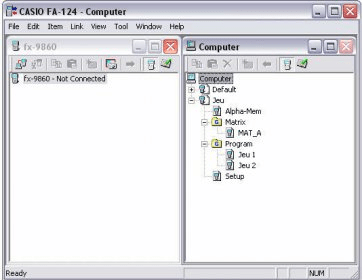First Impression of the New Caso Fx-CG10
Message #1 Posted by Namir on 12 Dec 2010, 1:44 p.m.Hi All, Two weeks ago, I received the new Casio Fc-CG10 color graphics calculator. This machine enhances on previous models, the Casio fx-9860G and the Casio fx-9860GII. The main enhancement, as the brief model name may hint at, is the addition of colors. This new features allows you to plot graphs in colors and even list data by varying the color of each list of columnar data. Like its predecessors, the CG10 uses an menu of icons and each icon leads to a multilevel set of menus. The Exit button serves to go up one level and you get used using the Exit key very quickly. The calculator supports lists and matrices. You can have up to 26 numbered lists (1 to 26). Also you can store up to six sets of lists internally. The CG10 supports up to 26 matrices, named A to Z. From programming aspect, the CG10 supports programs only. You can have a program call another as a subroutine. There are no parameters. The single-letter variables, 26 lists, and 26 matrices are accessible to all programs. So the programming model kind of resembles programming in GW-BASIC minus the line numbers. The CG10 supports For-Next loops, While loops, Do-While loops, IF-ELSE-THEN constructs, GOTO and labels, and also the ISZ and DSZ statements. The ISZ and DSZ statements will skip the next statement if the targeted counter (a variable) is zero. In addition to numeric variables, the CG10 programming commands also support a descent set of string operations. I wrote a few programs to solve for the root of an equation, calculate the square root using Newton's method, and perform multiple linear regression. Emulating functions by calling subroutines was basically programming with a global-only scope of data. You have to choose your variables carefully. The CG10 supports user prompt input and display output statements. The regression program exercised common matrix operations line transpose, invert, and multiply. As I worked with that program I realized it was easier to separately enter the matrices using the matrix editor and then run the program (especially for the sake of debugging and learning how to navigate with the CG10 commands). As I dug into the list of CG10 commands I was able to edit the regression program and make it run smoother and make it easier to use. The CG10 aalso supports spreadsheets that accepts numeric input or use formulas to calculate the contents of a cell. The Csaio Fx-CG10 calculator comes with a CD. You can load the Screen Receiver program. When you plug in the USB cable into the calculator and PC, you get a menu giving you options for how to proceed. I used the USB option to have the laptop view the Casio as a drive. This allows me to browse through the different folders and see the various data, graphics, and program files. You can backup these files into your PC. I was able to copy a CSV (Comma-Separated Values) file from the PC into the CG10 and then read that file as a set of list and also as a single matrix. This means that you can start with data in Excel, save the data as a CSV file, and then read it into the Casio. Using the lists you can then perform single or double variable statistics and regression (you can do linear and polynomial regression, sinusoidal, and other types of regressions). If you choose the screen receiver option while connected to the PC and while running the Screen Receiver software on the PC, then the PC will echo the screen that appears on the CG10. You can then capture screen to your heart's contents. The software does other things, but I only focused on screen capture in my brief overview of the CG10. Overall the Casio FX-CG10 is a nice machine with nice computing power. The programming features are OK--not too bad and not spectacular. The ability to connect to a PC and swap data is nice (and is also supported by programmable commands!). Namir | 